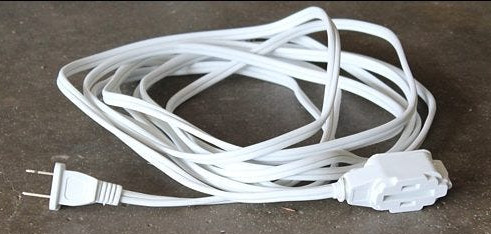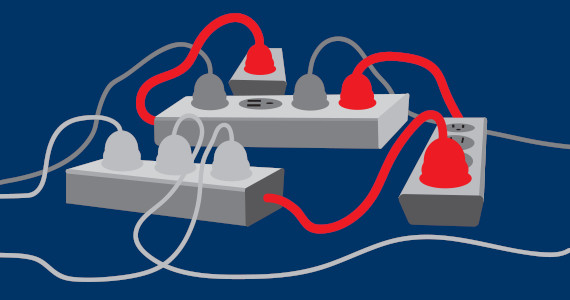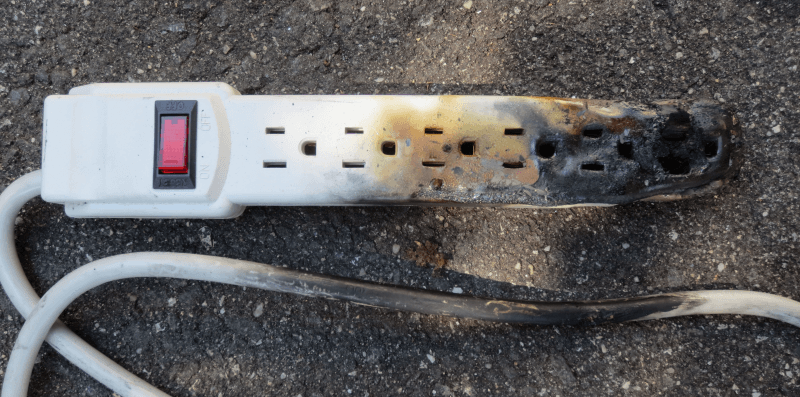I have connected two (or more!) power strips together many a time. I have plugged old 2-pronged power cords into old houses where the wall outlet doesn’t have a ground. I have daisy-chained those old power bars to enable the use of a computer that needed a 3-pronged outlet, by connecting to the grid via a modern power surge strip which is plugged into an old 2-pronged power strip to expand the old-fashioned 2-pronged wall outlet. I was always careful not to max out the strip by plugging too many devices into the daisy-chained power bars, and nothing bad happened. But is it possible (and likely) to overload a surge protector by connecting multiple power strips and surge protectors in a chain from one that is plugged into the wall outlet?

The main reasons that manufacturers recommend against daisy-chaining power bars are:
- Additional devices plugged into all the sockets could overload the outlet’s breaker rating.
- By using extension cords, or other surge protectors or outlet strips, the MOVs (the internal devices that actually divert excess energy) are placed farther away from the electrical ground and where the excess energy is diverted.
Can you plug 2 surge protectors into same wall outlet?
And how many devices can you plug into one surge protector?
Plus as many devices into a wall outlet as you want, but do not exceed the rated current draw or wattage requirement. Best to not exceed 75% of the wattage or current rating all together!
In the U.S., a typical outlet is rated at 15 amps, 120 volts. This equates to about 1800 watts. Some outlets may be rated for 20 amps, 120 volts, or 2400 watts max load. A 20 amp outlet can be identified if the neutral (long) slot is a horizontal “T” shape.
However even if an outlet is rated for a certain amperage, the maximum amperage that can be drawn from the outlet depends on the size of the circuit breaker and wiring, as well as other loads connected to the same circuit. For instance, in residential applications, it isn’t uncommon for a 15 amp outlet to be wired to a 20 amp breaker or fuse.
Theoretically, you could connect a load drawing more than 15 amps to the outlet, as long as no other loads are present on the circuit. However I would advise against this as the outlet itself could possibly overheat and pose a fire hazard.
If you have an electric stove or dryer, these appliances are plugged into special outlets rated at 240 volts at 50 and 30 amps, respectively. Larger window A/C units might require a 15 amp, 240 volt outlet. Such outlets are uncommon in new homes that have central A/C.
120 volt circuits are the most dangerous, though, since they are the most prone to overloading. I would advise against plugging the vacuum cleaner into the same outlet as the space heater, unless it is a 20 amp outlet on a 20 amp breaker. For future reference, you can calculate load using the equation P = VI, where P is power (watts), V is voltage (volts), and I is current (amps). To find current, just divide watts by volts.
Should you accidentally overload the circuit, the breaker will trip (or the fuse will blow) and de-energize the circuit before a fire starts. Just try to avoid doing so, and maybe figure out which outlets are on what breakers.
So, if you need to connect two or more surge suppressors for whatever reason, plug your suppressor unit (hopefully rated at 330-400 volts VPR, and 3000 joules, or higher) directly into the wall outlet, ensuring a good ground connection. If additional length is required, use a 14-gauge extension cord, or outlet strip for up to 10 feet, and a 12-gauge cord for 10-25 feet.
A suppressor unit plugged directly into the wall with a 6-8 foot 12- to 14-gauge power cord followed by an outlet strip with a 14-gauge power cord with multiple outlets should be fine if you don’t exceed 1350 watts or 11 amps in total device load (that’s for an 1800-watt rated unit). This combo will allow you up to sixteen feet of access from an outlet. If more is needed, you’d better find another outlet.
Will daisy-chaining two surge protectors double the clamping voltage?
Daisy-chaining several surge protectors together will not increase the clamping voltage accordingly; all of the MOV devices in the suppressor units are in parallel, and therefore the voltage across all of them is the same. So, if they clamp at 330 volts, then that voltage will appear across all units. However, if the first unit to fire is fried because of excessive energy, the second unit will fire when the voltage exceeds its clamping voltage VPR (voltage protection rating).

How can you tell the difference between a surge protector and a power strip?
Power strips and surge protectors are sometimes both called surge suppressors — but they are different.
Typically, power strips are cheap, multi-outlet devices that expand the number of plug-ins available on a wall outlet. These usually have a circuit breaker (on/off switch) of some sort, but most do not offer any real “surge protection” from electrical issues. Power strips are basically the equivalent of plugging a device directly into the wall direct.
If your power surge suppressor bar has a clamping voltage greater than 500 volts, it is essentially acting as a power strip and not as a surge suppressor.
What can you not put in a surge protector?
Technically you can plug any cord into a surge protector, but the point is to protect devices that have electronics in them from electricity surges. So, you don’t need to plug devices into a surge protector if those devices don’t have electronic components: freezers, fridges, blenders, etc.
What kind of power surge protector to use?
If you live in an area with lots of thunderstorms, your gear is probably more likely to experience power surges. Even if you live in the desert, your A/C or refrigerator could kick power spikes back down the lines to your electronics plugged into the wall.
There are multiple ways surges can enter the home, including the electrical system, coaxial cable, and also telephone (DSL) lines. Just as with coaxial systems, often surge protection for telephone lines is ignored, exposing modems, computers, and phone systems to dangerous surges.
Protecting your electrical service and not your coax cable or DSL line allows for surges to enter despite your best intentions or highest rated outlet surge protector. To prevent surge damage from Cable TV or Telephone lines, you need to surge protect in the same manner as power outlets, by stopping surges at the incoming cable TV utility service.
Installing a whole house surge protector might be the best option (especially considering the decline in quality control and misleading specs claimed by many surge protector manufacturers today).

Buy a UL-approved power bar or surge protector made by a reputable company like Matsushita, Siemens, or Vishay, and preferably not a cheaply made one from Taiwan or China.
Beware of the cheap, counterfeited UL-listed power bars and (mostly Chinese) manufacturers that do not pass the basic fire hazard resistance (on the plastic casing materials used) in their power bar. When the MOVs suffer from thermal overload and pop due to a surge, they will cause a small fire to the plastic casing, which may ended up burning down the house.